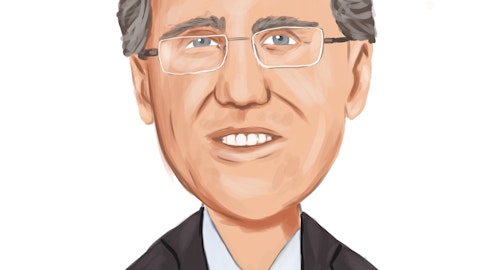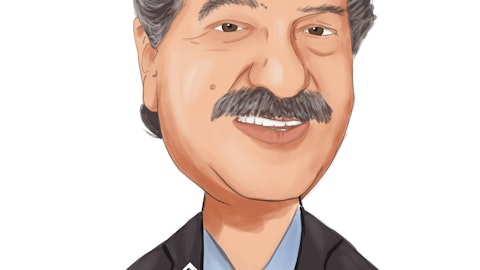Unidentified Analyst: Hi. This is George on for Steve. Congrats on closing the deal. It’s very exciting. I wanted to talk about the FY ’23 guide. I’m understanding correctly, the organic revenue growth guide came down a couple of points despite a really strong quarter. So I guess I’m wondering how much macro is potentially baked in there? How much conservatism, if you could just talk through that change. Thank you.
Madhu Ranganathan: Thank you again for your comments. It’s Madhu here. So when you look at fiscal — when you look at fiscal ’23, the OpenText growth trajectory, there’s no change in it, right? As we bring micro focus on for the five months, and when you look at it in aggregate, we are bringing Micro Focus on at a baseline in fiscal ’24 of $2.3 billion we shared, and we’ve also given you the five-month numbers. I would also urge that we — it’s not going to be reasonable to annualize the five-month number, just given their own seasonality and how their license and other aspects operate, which we understand quite well and then able to provide the baseline for fiscal ’24. So I would say OpenText organic growth rate is strong. Our cloud revenue growth rate remains strong, and it’s really the micro focus piece that we’re incorporating to the five months.
Unidentified Analyst: Got it. That makes sense. Thank you. And then one quick follow-up. You announced this headcount reduction cost savings plan. I’m just wondering, is that fully just according to your acquisition preplanned cost out or is there any element of kind of responding to some of the same pressures that some of your peers are facing that are going through similar programs? Thank you.
Madhu Ranganathan: Yes, Mark, do you want to take that and I can add as needed.
Mark Barrenechea: Yes, sure, George. Thanks for the question. We announced conjunctive with our announcement of our intent to acquire Micro Focus. We said we’d take out $400 million. And after closing here, we’re confirming we’re going to take out $400 million of expense. And our 8% reduction, rebalancing of the workforce is completely due to the acquisition. Our cloud bookings growth is growing 15% plus, as you can see. We had a stealth superb of Q2. And it’s interesting when you look at the economy and the factors out there, my best way to describe it is it’s uneven. There are very specific issues to companies and they need to all talk about their own companies. In relation to OpenText, our demand is strong. Digitalization is the only answer.
And you’re seeing that in our 16% cloud revenue growth, near 8% total revenue growth and our increased confidence in growing enterprise cloud bookings at 15% plus. The factors exist out there, for sure. But it’s uneven and disproportional. And digitalization is the only answer, and we’re doing well in this volatile time.
Madhu Ranganathan: Yes. And thank you, Mark. I was just going to add that before COVID or during COVID, the OpenText operating model has always been very thoughtful and measured adding the resources that is very conjunctive with growth and innovation. So the factors you hear outside are absolutely not applicable to us. Even now the rebalancing the workforce, as Mark shared in his comments will continue to hire in the sales and the product innovation areas.
Unidentified Analyst: Great. Thanks for taking the questions.
Mark Barrenechea: Yeah. Thank you, George.
Operator: The next question comes from Kevin Krishnaratne from Scotiabank. Please go ahead.
Kevin Krishnaratne: Hey there, good evening. Congrats on the deal. Very exciting times. Just a question for you on the — your outlook, 2024 to 2026 it’s an improving organic growth profile there. I’m just wondering, a lot of different moving pieces there, but how do we think about the contributions of, say, call it, straight-up cross-sell versus helping Micro Focus be maybe better cloud-enabled when it gets on to your cloud, private cloud platform versus renewal rate improvements. Just walk through the different pieces and what might be the bigger contributors to the improving organic growth rates over the next few years?





